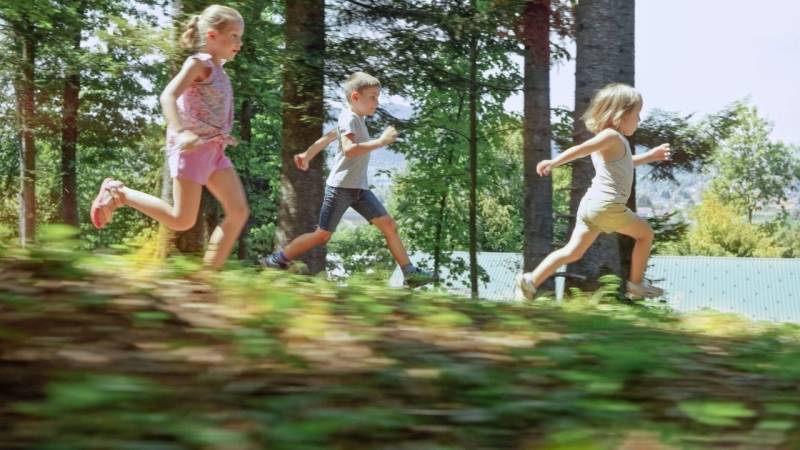
15 forest games that will definitely make your kids have fun in the forest
👉 The key facts from this guide
- Discover 15 forest games that are fun for children and allow them to have an intense nature experience.
- Games like "Find your tree", "The treasure" and "Creating forest mandalas" promote creativity and sensory perception.
- Throwing games like "Throwing sticks" and "Throwing pine cones" offer varied activities in the forest.
- Guessing games like "Guess the animals" and "What am I?" stimulate imagination and expand knowledge about nature.
- As an adult, you are a role model and initiator for the games and ensure a good atmosphere.
- Pay attention to safety in the forest, such as first aid equipment, tick protection, and handling fire.
What if your children never get bored in the forest and even have an intense nature experience?
Actually, this is possible when children do what they love most: playing.
The best news? With my 15 ideas, your children will undoubtedly spend their day full of energy and variety - and be exhausted in the evening.
Games are the gateway to nature
I know what it means when children don't know what to do with themselves. My two sons sometimes have those phases.
Even in the forest in the best mood, they ask when we will finally go home. Of course, all the plastic toys are much better than boring pine cones or lifeless stones.
But I made a vow to myself: Never again go out with the children unprepared. I always want to have an ace up my sleeve, like James Bond always had a hidden mini-pistol.
And even if a suggestion doesn't catch on, then I have the next idea in reserve.
I sat down and read, made phone calls, talked, and exchanged ideas with other parents and childcare providers.
The collected knowledge was then tested on my children. Yes, they had to serve as guinea pigs. But I can reassure you: They had a lot of fun with it.
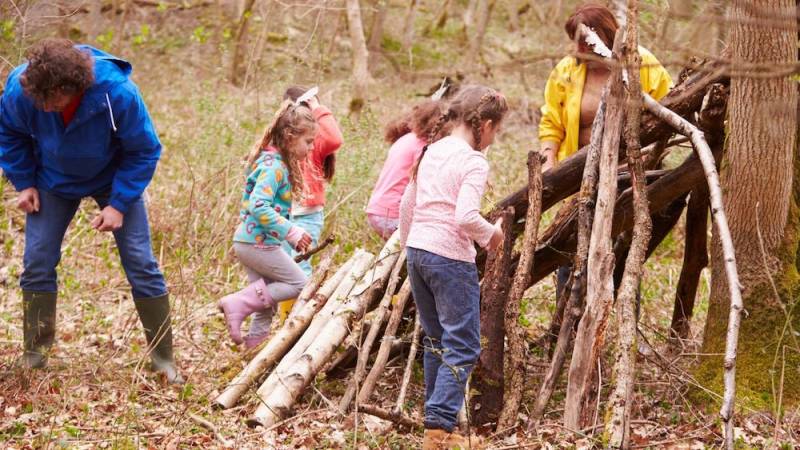
And the good thing about it is: All the games allow an approach to nature and make it possible to perceive oneself as part of nature.
You will now find the best games for the forest in my guide.
Let's go!
1. Find your tree
A wonderful game for children that challenges all senses.
- Blindfold the participant
- Spin them two to three times to disorient them (but not make them dizzy)
- Take their hand and lead them to a tree (take multiple turns to increase difficulty)
- Now the participant has about a minute to get to know the tree.
- Feel the bark
- Smell the tree
- Estimate the diameter
- Search for and feel the roots
- Lead the participant back to the starting point and remove the blindfold
- Now the participant must guess which tree they were at - they can feel, smell, and look at all the trees
The older the children are, the more difficult you make the game. Bring more trees, take more turns, and walk a longer distance.
At the end of the game, each child can say goodbye to their tree.
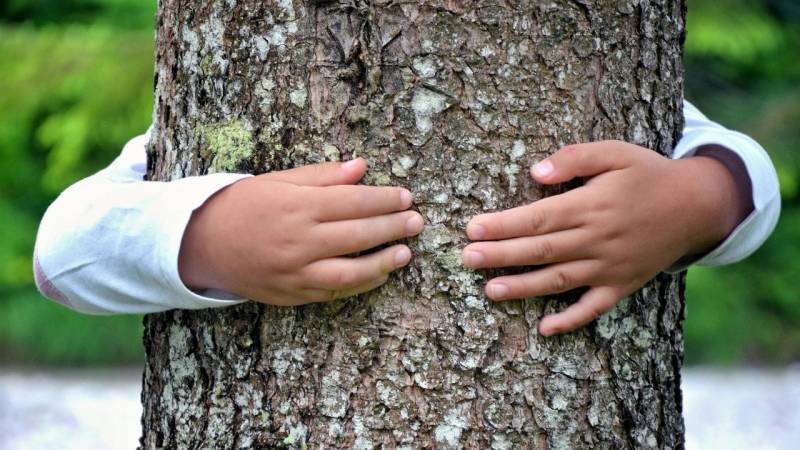
2. The Treasure
In this game, a blindfold is used. All the children sit in a circle and one child sits in the middle with the blindfold on. The child in the middle guards the treasure (a cone, a stone, a gem, a gold coin, etc.).
- All participants now try to sneak up on the treasure guardian one by one
- As soon as the treasure guardian hears a noise, they must point in that direction
- If the treasure guardian points at the sneaking child, they freeze and must return to their place
You can increase the difficulty by playing the game on a floor covered in leaves.

3. Creating Forest Mandalas
In this game, children get to know the forest by collecting various items. Creating forest mandalas is a calm game that allows children to be incredibly creative.
- Find a flat spot on the ground and remove any leaves or needles
- Now, gather various items from the forest, such as pine cones, fruits like acorns or berries, leaves, stones, sticks, moss, flowers, soil, needles, bark.
- Use one of the materials to create a circle, for example, using the pieces or pine cones
- Now, place the other materials inside the circle - however you like: mixed together or divided into quarters, etc.
To give you an idea, below you can see forest mandalas that I created with my children.
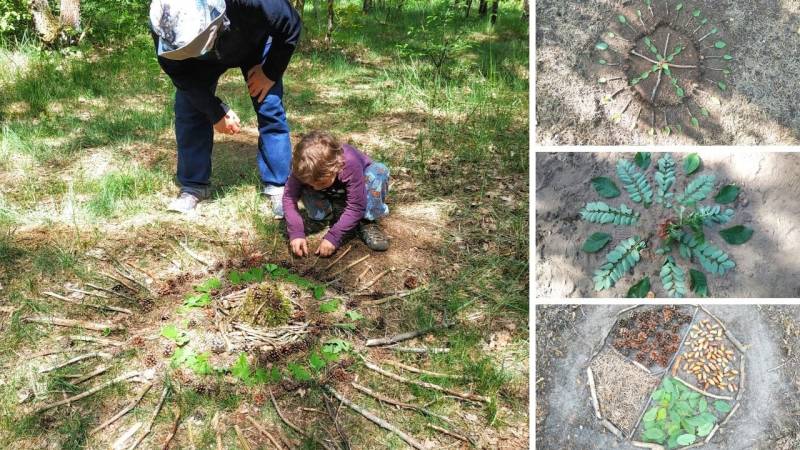
4. Let the feet guess
This game stimulates the children's sense of touch because their eyes are blindfolded.
- Collect cones, stones, acorns, sticks, pine needles, sand, soil, leaves, etc.
- Blindfold the participant
- Arrange the materials one after the other, like a road, but leave some distance between them
- Guide the participant barefoot over the materials
- The participant must guess what they are stepping on and standing on
If the game is too difficult with bare feet (especially for young children), use your hands to feel.
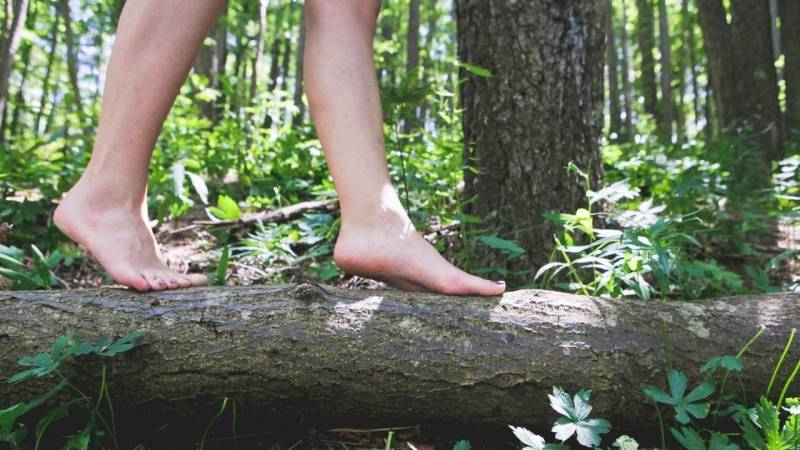
5. Smell it
The nose is used in the forest game.
Grab a few opaque cloths and wrap various forest objects in them that have a strong smell. For example, needles from coniferous trees, resin from a coniferous tree, pine cones, flowers, etc.
- The cloths are now passed around, preferably by an adult (you can often already feel what it is)
- Then everyone sniffs it and guesses what object it could be
If you are unsure when guessing, you can smell things in the surroundings to compare.
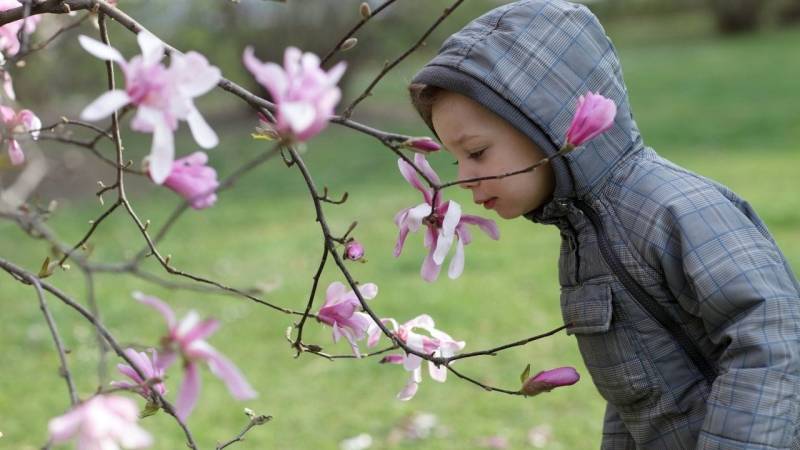
6. Forest Camera
For the game, you need at least two players. One is the camera, the other is the photographer. After a round, you switch roles.
- Participant 1 is the camera and closes their eyes
- Participant 2 is the photographer
- The photographer stands behind the camera and places both hands on the shoulders
- Now, with their eyes closed, the photographer guides the camera to a spot in the forest that they want to photograph (leaves, trees, stones, etc.)
- Then, the photographer positions the camera's head and presses the shutter: they tap on the shoulder, press an earlobe, or move the arm back and forth
- The camera then opens its eyes for 3 - 4 seconds and "takes" the photo
Take about 5 to 10 photos depending on the age of the children. At the end, ask the camera and the photographers which photo they liked the best.

7. Twin Search
A great search game in the forest. You will need a few cloth bags or small containers (five or more) to collect items (cones, stones, leaves, etc.) from the forest.
- Collect different items from the forest - one goes into each bag (but the items must occur multiple times in the surroundings)
- Each participant takes turns drawing a bag and then searches for the twin of the item from the bag in the surroundings
Depending on the age of the children, you will need to allocate more or less time for looking for the items. One minute is sufficient for older children. For younger children, you should conduct the game more loosely and without pressure.
Another variation: Instead of the bags, you can use a bedsheet or blanket. The collected items are placed on it. You show them to the children for 30 seconds and then everyone has to collect the items. In the end, you go through all the children's items and compare their characteristics and differences.
8. Catch the Prey
A fantastic game to activate the senses and learn about which animal hunts and eats other animals.
- All children sit in a circle (4–6 meters in diameter)
- Two children are the participants and their eyes are blindfolded
- One participant names a predator and the other names the corresponding prey (e.g., fox and mouse, wolf and rabbit, bear and lemmings)
- Both participants now move around the circle and the predator must locate the prey by listening
- If the participants get too close to the outer area of the circle, the other children tap the participant on the back
Tip: To increase the suspense, the circle can gradually shrink. It also adds realism if the participants make animal sounds.
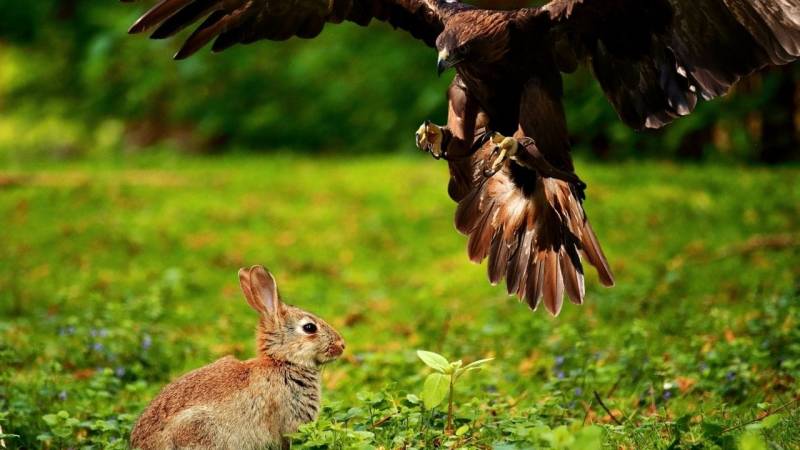
9. Find the Difference
You may be familiar with this game from home. You have to find the differences between two seemingly identical pictures. The game can also be wonderfully adapted to the forest and is especially suitable for young children.
- Find thin branches and place two frames side by side on the ground (2 x 1 meter is recommended)
- Now collect two identical forest objects (stones, flowers, pine cones, leaves, etc.) and place one object in each picture
- The participant now has time to memorize the pictures
- Then blindfold the participant and have another player remove or add an object
- Remove the blindfold from the participant - they must now guess what has changed
To make the game more difficult, change multiple objects.
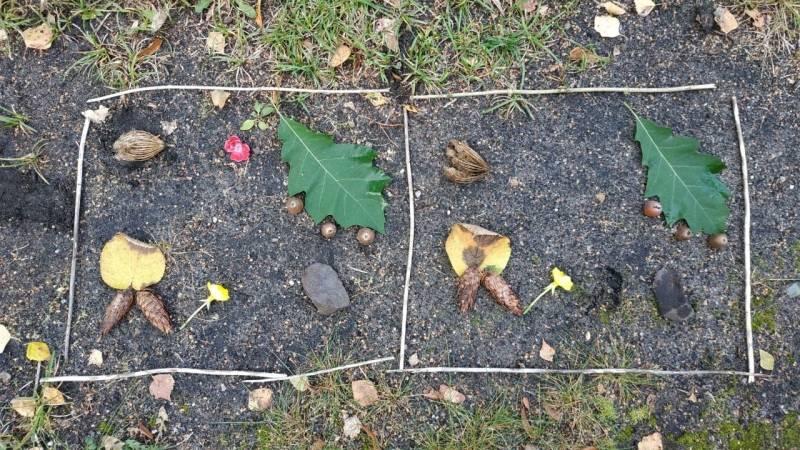
10. Throwing Sticks (Kubb/Viking Chess)
You may know the game by the name "Kubb" or "Viking Chess". In this game, children have to skillfully throw sticks and hit other sticks to make them fall over.
- Find 3 to 6 sticks that are 20 to 30 cm long and have a diameter of about 4 to 5 cm
- Find a flat surface and place the sticks there, standing upright, with a distance of 10 to 20 cm between them
- Then find a throwing stick, which should be about 20 cm long and have the same thickness as the other sticks
- Each participant now throws three times in a row, trying to knock down as many sticks as possible
To increase the difficulty of the game, you can move the throwing line further away from the sticks to be knocked down. Or you can place the sticks further apart.
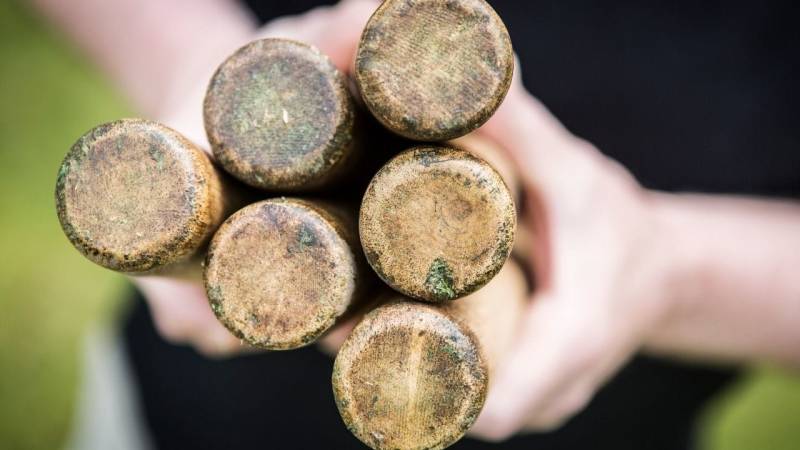
11. Throwing pine cones
In autumn, you can find many pine cones from the coniferous trees. And they are great for throwing.
- Each participant collects three pine cones
- Then choose a target, like a tree trunk or a large stone
- Draw a launch line on the ground and each player can throw their three pine cones at the target from there
If your children are younger, move the launch line closer, so they can hit the target easily. The player who hits the tree trunk the most times wins.
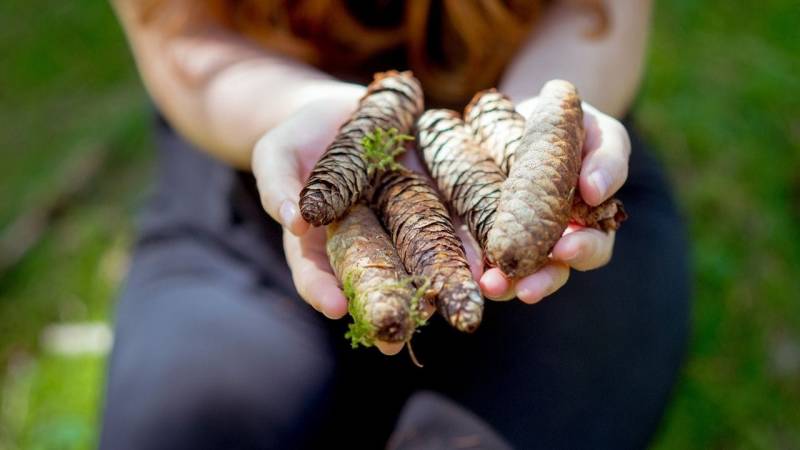
12. Guess the Animal
This game can be played not only in the forest, but also during boring car rides to grandma and grandpa's house. You probably already know how it goes:
- One child thinks of an animal, and the others take turns asking the child questions about the animal's characteristics
- The child can only answer with Yes, No, or Maybe
- Questions could include: "Do I have fur?", "Am I white?", "Can I fly/swim?", "Do I live in a cave?". I think you understand what I mean.
13. Search Missions
Prepare a few flashcards at home on which you write what should be collected. The game is good for children who can already read. For younger children, you read everything aloud.
- The cards might say, for example:
- something prickly
- something round
- something soft
- something hard
Alternative: The same game can be wonderfully done with search missions for colors. The cards then have different colors, like "something brown, red, green, white, etc.". Difficult colors like blue or yellow, you will probably only find in summer with flowers.
14. Blind Caravan
You need a rope and blindfolds for the game. Stretch the rope through the forest along trees and bushes. But don't stretch it too far, a blind person has to process many impressions.
- Put a blindfold on the participant
- The participant must now walk along the rope and feel their way cautiously
Alternatively, you can attach other objects to the rope that need to be felt. Exchange at the end what there was to feel and go back to the spots.

15. What am I?
Grab a large cardboard box and cut a hole in it that is just big enough for a fist to fit through.
Various items from the forest, such as chestnuts, pine cones, leaves, bark, sticks, and lichens, are then placed inside the box. Your child must then feel and touch the objects through the tactile opening to determine what they are.

What role you play as an adult
Please do not start suggesting a game and then leave the children to their devices.
You are in the role of the adult and must be a role model. You must lead by example. If the children do it themselves, great. If not, you are the one who must take the initiative.
Not only how you act, but also how you are tuned in to the stay, plays a big role.
If you go into the forest with joy, good mood and power, your children will most likely follow you - and be infected.
So, you are responsible for creating a good atmosphere as an adult, you can't expect that from the children.
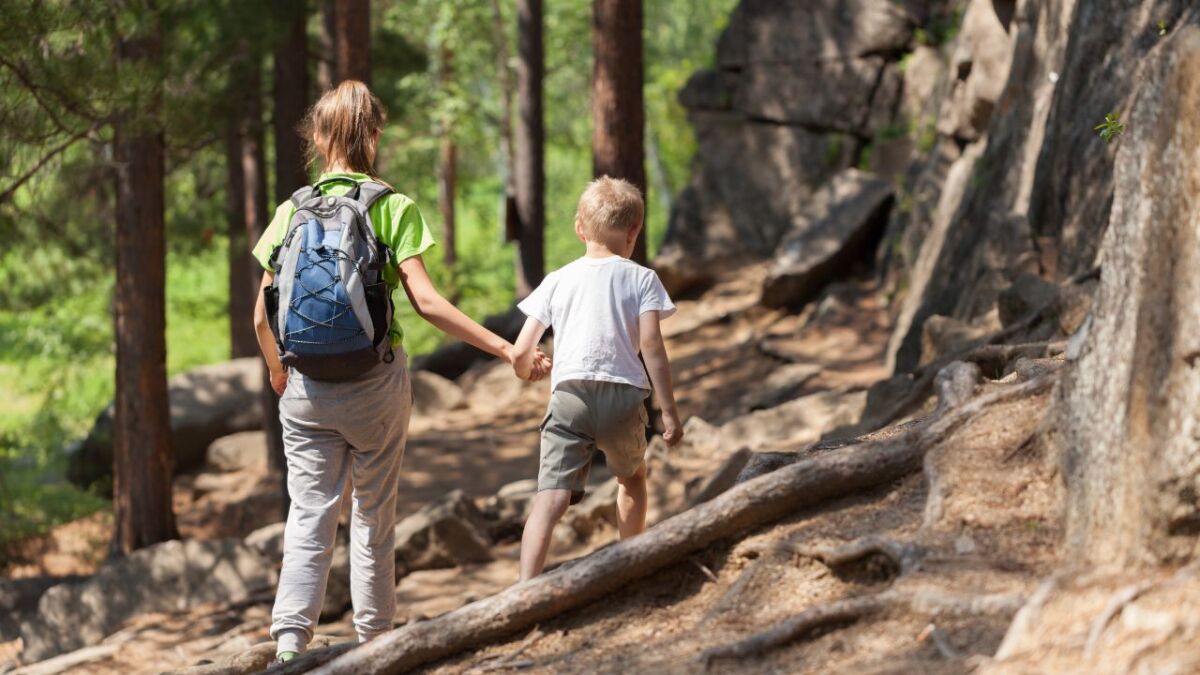
Notes on the forest games
There isn't much you need to keep in mind, but please respect these rules:
- never collect living things, such as insects, live plants or fungi
- take down your games after your visit to the forest (sticks, frames, etc.)
Some games involve blindfolds. Older children can easily put them on, but younger children may sometimes be fearful and unsure. In that case, do not force the child to wear it, but let them play the game with their eyes closed. And whenever they feel unsure, they can open their eyes themselves.
Read also
41 Bushcraft Ideas with Children - kid-friendly outdoor activities for parents, groups, and classes – Here you will find 41 great kid-friendly outdoor activities to introduce your children to Bushcrafting and nature. Perfect for family activities.
Dangers in the Forest
As beautiful as the forest may be, it can also be dangerous.
In addition, some children and adults are no longer accustomed to the forest. They simply have no idea about it. If you are one of them, then I strongly recommend you to take my advice to heart.
- The most important thing: Your first aid kit. Always take it with you. Always!
- Fire in the forest: Put out cigarettes and especially open fire.
- Do not collect unknown mushrooms and do not bring them into the games.
- Ticks: Unfortunately, there are more and more of them. Read more about it here and how to protect yourself.
- Fox tapeworm: These nasty fellows also exist.
- Accidents: Incidents will always happen. But please be especially careful in difficult terrain. Watch out for rocks, large stones, and old rotten trees. If you are building a camp, read this article.
Conclusion
Print out the games and take them with you into the forest.
Hide it from me in your bag or in another place that is always within reach.
And then one day the situation will come again where your children demand a proposal.
Then take out the list…
From now on, you are well-prepared.
And if you want to end the day with a campfire together, be sure to check out these 11 simple and delicious recipes for a campfire with children, which will ensure unforgettable evenings.
If this list is still not enough for you, then I have more for your play and adventure heart.
👉 100 ideas for micro-adventures with children - finally more fun in nature!
Do you want to suggest a game? Then share your idea in the comments. I also appreciate feedback.


Author of the guide
Martin Gebhardt
Hey, I'm Martin. On my blog, you will learn the basics and numerous details about living in the wild. I think survival, bushcraft and the good life in nature are the keys to happiness. Find me here on Instagram or on YouTube. You can find more about my mission on the About Me page.
Was this guide helpful?
94 people found this guide helpful.
4.96 out of 5 points (95 Ratings)
Comments (1)
This post may contain affiliate links. So if you click on the links and make a purchase, I will receive a small commission at no additional cost to you. Click here, to learn more about it.


